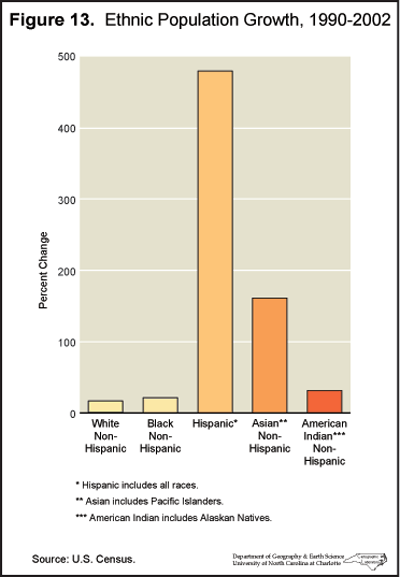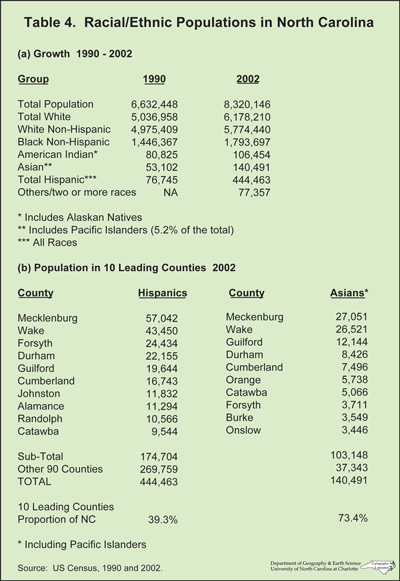General Demographics
by Alfred W. Stuart
Professor Emeritus of Geography, University of North Carolina at Charlotte, 2010.
Reprinted with permission from The North Carolina Atlas Revisited. Managing editor: Alfred W. Stuart.
Part 1: Overview


The most dramatic change in North Carolina’s demographic history post-colonization has been the rapid change in its ethnic composition. For many decades the state has been characterized by a population that was dominated by whites and a smaller but substantial proportion of African Americans. Included also was a smaller concentration of Native Americans. Recently, however, the state has attracted large numbers of both Hispanics and Asians. Hispanics are a cultural group, not ethnic, and, in fact about 85 percent of North Carolina’s Hispanics are white and most of the rest are black. However, they are distinctive because of their Latino culture, including surnames, language and diet. As Figure 13 and Table 4a show, the state’s Hispanic population more than quadrupled between 1990 and 2002 and Asians more than doubled in number. The state's 479 percent growth rate for Hispanics ranked first among all the states and North Carolina's total Hispanic population moved from 28th to 15th largest in the nation between 1900 and 2000. However, by 2002 Latinos made up only 5.3 percent of the state total, well below the national share of 12.5 percent. Clearly, a large share of the state’s strong growth due to in-migration is accounted for by the dramatic growth of these several population groups. As a result of these changes, the state has an increasingly diverse population. However, the non-Hispanic white and African American populations still comprised over 91 percent of the state total in 2002.
Recent US Census estimates show that Latinos of all races in North Carolina increased by 138,654 between the 2000 Census and July 1, 2004, from 378,963 to 517,617, a gain of nearly 37 percent. This is in contrast with the state's overall growth rate of just 6.1 percent. In fact, Latinos accounted for over 28 percent of the state's net growth during this period, which increased their share of the total from 4.7 to 6.1 percent. In similar fashion, the Asian population grew to 171,600 by 2004, a rise of over 25 percent during this period. This brought their share of the state total from 1.7 to 2.0 percent.
A report from the Washington, DC-based Pew Hispanic Center estimates that North Carolina has over 300,000 undocumented immigrants in its population, 3% of the US total.. This ranks the state 8th highest among all US states. Most of these illegal immigrants are thought to be from Mexico. The study is based upon a March 2004 survey by the US Bureau of Labor Statistics and the Census Bureau. About half of all immigrants living in the state are thought to be undocumented. North Carolina has become a popular destination for these immigrants who, in the past, tended to be drawn to the nation's larger cities.
Table 4b shows that in 2002 there was a pronounced urban tendency in the distribution of Hispanics and, even more so, for Asians. Over half of all Hispanics were in 10 counties that were parts of five metro areas. Even more striking, over 73 percent of the state’s Asians were found in just 10 counties, again, all parts of metro areas.
It should be noted that the 2000 Census was the first to include a category called “Other,” which included anyone reporting that they were of mixed ethnic parentage. Apparently a number of people who in earlier censuses listed themselves as Native American or black reported themselves in this new category in 2000.
A report released by The Brookings Institute in May, 2006, "Diversity Spreads Out," showed that North Carolina's largest metro areas have been highly attractive to some minority groups. The Charlotte-Gastonia-Concord MSA ranked second nationally with a 49.8% growth rate in its Hispanic population between 2000 and 2004, followed in 3rd place by the Raleigh-Cary MSA at 46.7%. The two areas also ranked high during the same period in the increase in their Black populations. Raleigh-Cary ranked 5th nationally with a 15.2% gain while Charlotte-Gastonia-Concord was 10th with a 13.7% gain.
Keep reading >> General Demographics- Part 2: Asian ![]()
1 January 2010 | Stuart, Alfred W.